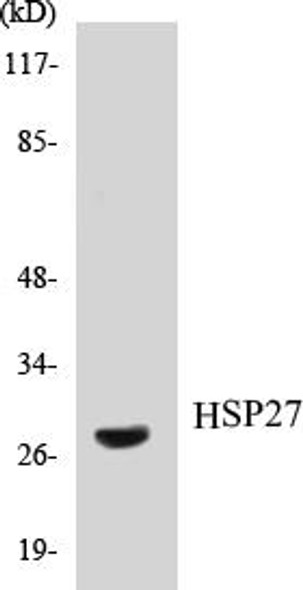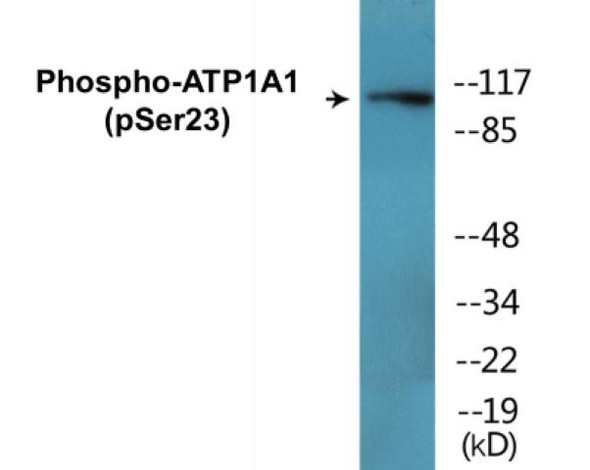HSP27 (Phospho-Ser82) Colorimetric Cell-Based ELISA Kit
- SKU:
- CBCAB00072
- Product Type:
- ELISA Kit
- ELISA Type:
- Cell Based Phospho Specific
- Research Area:
- Immunology
- Reactivity:
- Human
- Mouse
- Rat
- Detection Method:
- Colorimetric
Description
HSP27 (Phospho-Ser82)Colorimetric Cell-Based ELISA Kit
The HSP27 (Phospho-Ser82) Colorimetric Cell-Based ELISA Kit is a powerful tool for researchers studying the role of HSP27 phosphorylation in cellular stress response. This kit allows for quantitative measurement of phosphorylated HSP27 at Ser82 in cell lysates, providing valuable insights into the activation of this important chaperone protein.HSP27 is a key player in the cellular stress response, protecting cells from damage and promoting survival under adverse conditions. Phosphorylation at Ser82 has been linked to changes in HSP27 function and cellular signaling pathways, making it a crucial site for studying the regulatory mechanisms of this protein.
With high sensitivity and specificity, this ELISA kit delivers accurate and reliable results, enabling researchers to explore the role of HSP27 phosphorylation in various physiological and pathological processes. Whether investigating cancer progression, neurodegenerative disorders, or other diseases, this kit is an essential tool for advancing our understanding of HSP27 biology and its potential as a therapeutic target.
| Product Name: | HSP27 (Phospho-Ser82) Colorimetric Cell-Based ELISA |
| Product Code: | CBCAB00072 |
| ELISA Type: | Cell-Based |
| Target: | HSP27 (Phospho-Ser82) |
| Reactivity: | Human, Mouse, Rat |
| Dynamic Range: | > 5000 Cells |
| Detection Method: | Colorimetric 450 nm |
| Format: | 2 x 96-Well Microplates |
The HSP27 (Phospho-Ser82) Colorimetric Cell-Based ELISA Kit is a convenient, lysate-free, high throughput and sensitive assay kit that can detect HSP27 protein phosphorylation and expression profile in cells. The kit can be used for measuring the relative amounts of phosphorylated HSP27 in cultured cells as well as screening for the effects that various treatments, inhibitors (ie. siRNA or chemicals), or activators have on HSP27 phosphorylation.
Qualitative determination of HSP27 (Phospho-Ser82) concentration is achieved by an indirect ELISA format. In essence, HSP27 (Phospho-Ser82) is captured by HSP27 (Phospho-Ser82)-specific primary antibodies while the HRP-conjugated secondary antibodies bind the Fc region of the primary antibody. Through this binding, the HRP enzyme conjugated to the secondary antibody can catalyze a colorimetric reaction upon substrate addition. Due to the qualitative nature of the Cell-Based ELISA, multiple normalization methods are needed:
| 1. | A monoclonal antibody specific for human GAPDH is included to serve as an internal positive control in normalizing the target absorbance values. |
| 2. | Following the colorimetric measurement of HRP activity via substrate addition, the Crystal Violet whole-cell staining method may be used to determine cell density. After staining, the results can be analysed by normalizing the absorbance values to cell amounts, by which the plating difference can be adjusted. |
| Database Information: | Gene ID: 3315, UniProt ID: P04792, OMIM: 602195/606595/608634, Unigene: Hs.520973 |
| Gene Symbol: | HSPB1 |
| Sub Type: | Phospho |
| UniProt Protein Function: | HSP27: a small heat shock protein that is regulated both transcriptionally and posttranslationally. Modulates actin polymerization and reorganization. Its expression level increases several-fold in response to stress and is phosphorylated by MAPKAP kinase 2. Cytoplasmic in interphase cells. Colocalizes with mitotic spindles in mitotic cells. Translocates to the nucleus during heat shock. |
| UniProt Protein Details: | Protein type:Chaperone; Motility/polarity/chemotaxis; Heat shock protein Chromosomal Location of Human Ortholog: 7q11.23 Cellular Component: proteasome complex; extracellular space; focal adhesion; cytoskeleton; cytoplasm; plasma membrane; spindle; Z disc; nucleus; cytosol Molecular Function:identical protein binding; protein kinase C inhibitor activity; protein binding; ubiquitin binding; protein kinase C binding; protein kinase binding Biological Process: positive regulation of interleukin-1 beta production; positive regulation of tumor necrosis factor biosynthetic process; retinal homeostasis; positive regulation of angiogenesis; response to virus; positive regulation of blood vessel endothelial cell migration; negative regulation of protein kinase activity; gene expression; vascular endothelial growth factor receptor signaling pathway; cell motility; regulation of I-kappaB kinase/NF-kappaB cascade; response to unfolded protein; negative regulation of apoptosis; regulation of translational initiation Disease: Neuronopathy, Distal Hereditary Motor, Type Iib; Charcot-marie-tooth Disease, Axonal, Type 2f |
| NCBI Summary: | The protein encoded by this gene is induced by environmental stress and developmental changes. The encoded protein is involved in stress resistance and actin organization and translocates from the cytoplasm to the nucleus upon stress induction. Defects in this gene are a cause of Charcot-Marie-Tooth disease type 2F (CMT2F) and distal hereditary motor neuropathy (dHMN). [provided by RefSeq, Oct 2008] |
| UniProt Code: | P04792 |
| NCBI GenInfo Identifier: | 19855073 |
| NCBI Gene ID: | 3315 |
| NCBI Accession: | P04792.2 |
| UniProt Secondary Accession: | P04792,Q6FI47, Q96C20, Q96EI7, Q9UC31, Q9UC34, Q9UC35 Q9UC36, B2R4N8, |
| UniProt Related Accession: | P04792 |
| Molecular Weight: | 205 |
| NCBI Full Name: | Heat shock protein beta-1 |
| NCBI Synonym Full Names: | heat shock 27kDa protein 1 |
| NCBI Official Symbol: | HSPB1 |
| NCBI Official Synonym Symbols: | CMT2F; HMN2B; HSP27; HSP28; Hsp25; SRP27; HS.76067; HEL-S-102 |
| NCBI Protein Information: | heat shock protein beta-1; HSP 27; 28 kDa heat shock protein; heat shock 27 kDa protein; heat shock 27kD protein 1; stress-responsive protein 27; estrogen-regulated 24 kDa protein; epididymis secretory protein Li 102 |
| UniProt Protein Name: | Heat shock protein beta-1 |
| UniProt Synonym Protein Names: | 28 kDa heat shock protein; Estrogen-regulated 24 kDa protein; Heat shock 27 kDa protein; HSP 27; Stress-responsive protein 27; SRP27 |
| Protein Family: | Heat shock protein |
| UniProt Gene Name: | HSPB1 |
| UniProt Entry Name: | HSPB1_HUMAN |
| Component | Quantity |
| 96-Well Cell Culture Clear-Bottom Microplate | 2 plates |
| 10X TBS | 24 mL |
| Quenching Buffer | 24 mL |
| Blocking Buffer | 50 mL |
| 15X Wash Buffer | 50 mL |
| Primary Antibody Diluent | 12 mL |
| 100x Anti-Phospho Target Antibody | 60 µL |
| 100x Anti-Target Antibody | 60 µL |
| Anti-GAPDH Antibody | 60 µL |
| HRP-Conjugated Anti-Rabbit IgG Antibody | 12 mL |
| HRP-Conjugated Anti-Mouse IgG Antibody | 12 mL |
| SDS Solution | 12 mL |
| Stop Solution | 24 mL |
| Ready-to-Use Substrate | 12 mL |
| Crystal Violet Solution | 12 mL |
| Adhesive Plate Seals | 2 seals |
The following materials and/or equipment are NOT provided in this kit but are necessary to successfully conduct the experiment:
- Microplate reader able to measure absorbance at 450 nm and/or 595 nm for Crystal Violet Cell Staining (Optional)
- Micropipettes with capability of measuring volumes ranging from 1 µL to 1 ml
- 37% formaldehyde (Sigma Cat# F-8775) or formaldehyde from other sources
- Squirt bottle, manifold dispenser, multichannel pipette reservoir or automated microplate washer
- Graph paper or computer software capable of generating or displaying logarithmic functions
- Absorbent papers or vacuum aspirator
- Test tubes or microfuge tubes capable of storing ≥1 ml
- Poly-L-Lysine (Sigma Cat# P4832 for suspension cells)
- Orbital shaker (optional)
- Deionized or sterile water
*Note: Protocols are specific to each batch/lot. For the correct instructions please follow the protocol included in your kit.
| Step | Procedure |
| 1. | Seed 200 µL of 20,000 adherent cells in culture medium in each well of a 96-well plate. The plates included in the kit are sterile and treated for cell culture. For suspension cells and loosely attached cells, coat the plates with 100 µL of 10 µg/ml Poly-L-Lysine (not included) to each well of a 96-well plate for 30 minutes at 37°C prior to adding cells. |
| 2. | Incubate the cells for overnight at 37°C, 5% CO2. |
| 3. | Treat the cells as desired. |
| 4. | Remove the cell culture medium and rinse with 200 µL of 1x TBS, twice. |
| 5. | Fix the cells by incubating with 100 µL of Fixing Solution for 20 minutes at room temperature. The 4% formaldehyde is used for adherent cells and 8% formaldehyde is used for suspension cells and loosely attached cells. |
| 6. | Remove the Fixing Solution and wash the plate 3 times with 200 µL 1x Wash Buffer for five minutes each time with gentle shaking on the orbital shaker. The plate can be stored at 4°C for a week. |
| 7. | Add 100 µL of Quenching Buffer and incubate for 20 minutes at room temperature. |
| 8. | Wash the plate 3 times with 1x Wash Buffer for 5 minutes each time. |
| 9. | Add 200 µL of Blocking Buffer and incubate for 1 hour at room temperature. |
| 10. | Wash 3 times with 200 µL of 1x Wash Buffer for 5 minutes each time. |
| 11. | Add 50 µL of 1x primary antibodies Anti-HSP27 (Phospho-Ser82) Antibody, Anti-HSP27 Antibody and/or Anti-GAPDH Antibody) to the corresponding wells, cover with Parafilm and incubate for 16 hours (overnight) at 4°C. If the target expression is known to be high, incubate for 2 hours at room temperature. |
| 12. | Wash 3 times with 200 µL of 1x Wash Buffer for 5 minutes each time. |
| 13. | Add 50 µL of 1x secondary antibodies (HRP-Conjugated AntiRabbit IgG Antibody or HRP-Conjugated Anti-Mouse IgG Antibody) to corresponding wells and incubate for 1.5 hours at room temperature. |
| 14. | Wash 3 times with 200 µL of 1x Wash Buffer for 5 minutes each time. |
| 15. | Add 50 µL of Ready-to-Use Substrate to each well and incubate for 30 minutes at room temperature in the dark. |
| 16. | Add 50 µL of Stop Solution to each well and read OD at 450 nm immediately using the microplate reader. |
(Additional Crystal Violet staining may be performed if desired – details of this may be found in the kit technical manual.)










